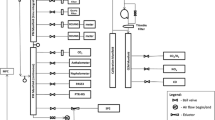Abstract
Object: Diesel soot has been recognized as probably carcinogenic to humans. Elemental carbon (also called black carbon) in soot is considered at the moment as the most significant surrogate to be measured for assessing the exposure to this pollutant. Its analysis is done by combustion in an oven and determination of the CO2 formed, after elimination of the organic fraction of the soot by heating and/or by solvent extraction. The analysis allows determination of both fractions of the soot: “elemental carbon” (EC) and organic carbon␣(OC). The sum of EC and OC is called TC (total carbon). Method: An informal European coordination group organized two round robin tests on filter samples collected from diluted diesel emissions. The first round (RRT1) was performed on 13 different samples analyzed by ten laboratories. The range of loading was 2.5 to 150 μg/cm2 of EC. No evaluation of the precision within laboratories could be made since each laboratory gave only one result per sample. Therefore a second round (RRT2) was organized with two samples and a blank filter sent in several portions to 11 laboratories. It should be stressed that each laboratory used its own method and that no standardization was planned at this stage. Results: Results of RRT1 showed that the coefficient of variation between laboratories decreased with higher loading and was around 10% to 15% for EC above about 20 μg/cm2. Dispersion of the results varied and it appeared that the way OC is removed from the soot is probably the most important factor of influence. The correlation between the laboratories was good as a whole but some systematic differences could be detected. Besides the different techniques to remove the organic carbon, the pretreatment of the filter by HCl (either as a vapor or as a solution) to remove the inorganic carbonates (potential interference sources), is probably also a significant factor of influence in the dispersion of the results between laboratories. It is not yet clear from these results whether the “environmental” laboratories give different results from the “occupational” laboratories, but it is clear that their objectives differ since for the “environmentalists”, EC is not a specific marker of diesel immissions, in contrast to the “occupationalists”. Conclusion: It can be concluded that, although significant differences exist between laboratories they can be attributed mainly to the narrow distribution of the results within a single laboratory, and that the overall agreement of the results for EC and TC is fairly good. These results obtained with pure diesel engine emissions, should be complemented by field samples, but they have already achieved relevant findings in the performance of the procedures used to assess exposure to diesel soot.
Similar content being viewed by others
Author information
Authors and Affiliations
Additional information
Received: 30 December 1996 / Accepted: 21 February 1997
Rights and permissions
About this article
Cite this article
Guillemin, M., Cachier, H., Chini, C. et al. International round robin tests on the measurement of carbon in diesel exhaust particulates. Int Arch Occup Environ Health 70, 161–172 (1997). https://doi.org/10.1007/s004200050202
Issue Date:
DOI: https://doi.org/10.1007/s004200050202




